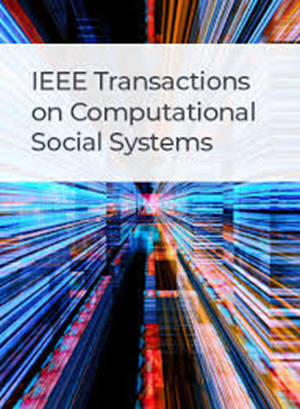基于社区增强的动态图卷积网络的社交网络谣言检测
IF 4.5
2区 计算机科学
Q1 COMPUTER SCIENCE, CYBERNETICS
IEEE Transactions on Computational Social Systems
Pub Date : 2024-12-11
DOI:10.1109/TCSS.2024.3505892
引用次数: 0
摘要
随着社交平台的日益普及,网络环境中的谣言已经成为对人类社会的重大威胁之一。现有的谣言检测方法忽略了对谣言传播网络社区结构的建模和分析。本文提出了一种新的社区增强动态图卷积网络(CDGCN)用于在线社交网络上的有效谣言检测,该网络利用谣言传播过程中形成的社区来提高谣言检测的准确性。CDGCN采用一种结合节点特征和拓扑特征的设计方法来识别社区,学习谣言的社区特征。在此基础上,提出了一种具有社区感知关注机制的图卷积网络(GCN),使节点能够从相邻节点的全局和社区特征中动态聚合信息,有效地对关键邻居信息进行优先级排序,增强局部社区结构和全局网络模式的表示,从而提高分析性能。GCN生成的最终谣言表示由分类器处理以检测虚假谣言。在四个真实数据集上进行了全面的实验和对比研究,验证了CDGCN的有效性。本文章由计算机程序翻译,如有差异,请以英文原文为准。
Community-Enhanced Dynamic Graph Convolutional Networks for Rumor Detection on Social Networks
Along with the increasing popularization of social platforms, rumors in the Web environment have become one of the significant threats to human society. Existing rumor detection methods ignore modeling and analyzing the community structure of the rumor propagation network. This article proposes a new community-enhanced dynamic graph convolutional network (CDGCN) for effective rumor detection on online social networks, which utilize the communities formed in a rumor propagation process to improve rumor detection accuracy. CDGCN uses a designed method that combines node features and topology features to identify the communities and learn the community features of rumors. Following this, a graph convolutional network (GCN) with a community-aware attention mechanism is proposed to enable the nodes to dynamically aggregate information from their neighboring nodes’ global and community features, effectively prioritizing critical neighborhood information, enhancing the representation of both local community structures and global network patterns for improved analytical performance. The final rumor representations generated by the GCN are processed by a classifier to detect false rumors. Comprehensive experiments and comparison studies are conducted on four real-world datasets to validate the effectiveness of CDGCN.
求助全文
通过发布文献求助,成功后即可免费获取论文全文。
去求助
来源期刊

IEEE Transactions on Computational Social Systems
Social Sciences-Social Sciences (miscellaneous)
CiteScore
10.00
自引率
20.00%
发文量
316
期刊介绍:
IEEE Transactions on Computational Social Systems focuses on such topics as modeling, simulation, analysis and understanding of social systems from the quantitative and/or computational perspective. "Systems" include man-man, man-machine and machine-machine organizations and adversarial situations as well as social media structures and their dynamics. More specifically, the proposed transactions publishes articles on modeling the dynamics of social systems, methodologies for incorporating and representing socio-cultural and behavioral aspects in computational modeling, analysis of social system behavior and structure, and paradigms for social systems modeling and simulation. The journal also features articles on social network dynamics, social intelligence and cognition, social systems design and architectures, socio-cultural modeling and representation, and computational behavior modeling, and their applications.
 求助内容:
求助内容: 应助结果提醒方式:
应助结果提醒方式:


